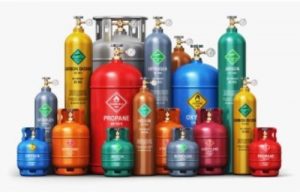 According to the Occupational Safety and Health Administration Standard 29 CFR 1926 Subpart J, compressed gas cylinders require significant considerations.
According to the Occupational Safety and Health Administration Standard 29 CFR 1926 Subpart J, compressed gas cylinders require significant considerations.
Transporting, Moving, and Storing Compressed Gas Cylinders
Remember the following:
- One must not hoist or transport by means of magnets or choker slings. Secure hoisted cylinders in a cradle, sling board, or pallet;
- One must not intentionally drop, strike together violently, or permit cylinders to be struck. Tilt and roll them on their bottom edges;
- If frozen in place, thaw cylinder loose, use warm, not boiling water. Never use a bar to pry cylinders loose by placing the bar under valves or protection caps;
- Secure cylinders on a special carrier designed for this intended this purpose. Use a cylinder truck, chain, or other steadying device to keep cylinders from being knocked over;
- Remove regulator from the cylinder and put in place valve protection caps before cylinders are moved in, not on, special carrier;
- Store oxygen cylinders, fuel-gas cylinders, or combustible materials (especially oil or grease) at a minimum distance of 20 feet apart or they must have an approved barrier;
- Store cylinders in a well-protected, well-ventilated, dry location indoors, at least 20 feet from highly combustible materials.
REMEMBER compressed gas cylinders are dangerous and could be become explosive if not transported, moved, or stored correctly.
COMPRESSED GAS CYLINDERS ARE TOUCHY!
Download flyer: STOTW_1106_Gas_Cylinder_Safety Download Spanish flyer: STOTW_1106_Gas_Cylinder_Safety_esp

